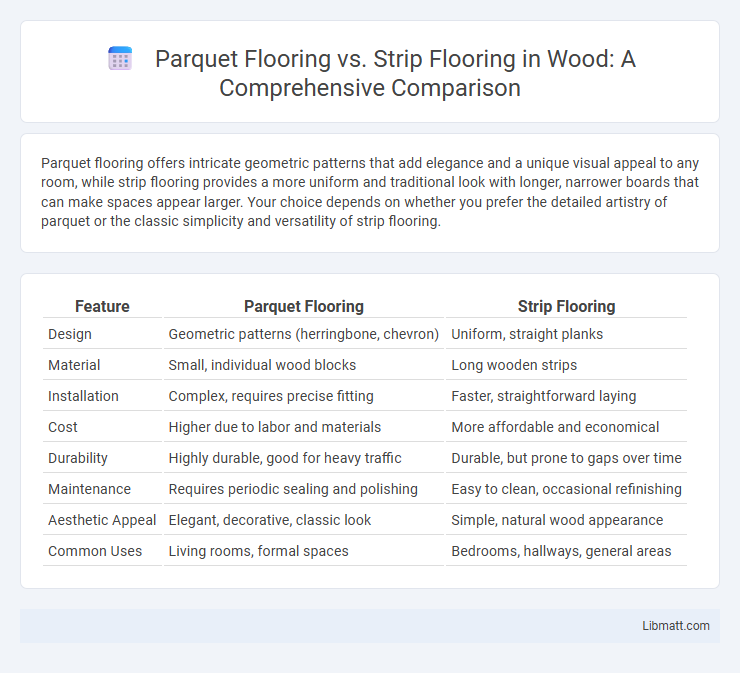Parquet flooring offers intricate geometric patterns that add elegance and a unique visual appeal to any room, while strip flooring provides a more uniform and traditional look with longer, narrower boards that can make spaces appear larger. Your choice depends on whether you prefer the detailed artistry of parquet or the classic simplicity and versatility of strip flooring.
Table of Comparison
| Feature | Parquet Flooring | Strip Flooring |
|---|---|---|
| Design | Geometric patterns (herringbone, chevron) | Uniform, straight planks |
| Material | Small, individual wood blocks | Long wooden strips |
| Installation | Complex, requires precise fitting | Faster, straightforward laying |
| Cost | Higher due to labor and materials | More affordable and economical |
| Durability | Highly durable, good for heavy traffic | Durable, but prone to gaps over time |
| Maintenance | Requires periodic sealing and polishing | Easy to clean, occasional refinishing |
| Aesthetic Appeal | Elegant, decorative, classic look | Simple, natural wood appearance |
| Common Uses | Living rooms, formal spaces | Bedrooms, hallways, general areas |
Introduction to Parquet and Strip Flooring
Parquet flooring consists of small wood pieces arranged in decorative, geometric patterns, offering a classic and intricate aesthetic. Strip flooring features long, narrow planks laid continuously to highlight the natural grain and create a seamless look. Your choice between parquet and strip flooring influences both the visual style and installation complexity of your space.
Defining Parquet Flooring
Parquet flooring consists of small wooden pieces arranged in intricate geometric patterns, offering a decorative and artistic appearance. It provides greater design flexibility compared to strip flooring, which typically features long, narrow planks laid parallel. Parquet flooring is known for enhancing aesthetic appeal in both residential and commercial interiors through its unique textures and patterns.
Understanding Strip Flooring
Strip flooring consists of narrow wooden planks, typically between 1 1/2 to 3 inches wide, installed in parallel rows to create a seamless, uniform appearance. It offers a classic, timeless look that enhances the visual length of your space and is often easier to install and repair compared to parquet flooring. Choosing strip flooring provides durability and a straightforward design that complements both traditional and modern interiors.
Material Composition and Construction
Parquet flooring consists of small wood pieces arranged in geometric patterns, made from hardwoods like oak, maple, or walnut, offering intricate designs and durability. Strip flooring features long, narrow strips of solid or engineered wood, typically oak or pine, providing a uniform appearance with easy installation and maintenance. Your choice depends on the desired aesthetic and the wood species, as parquet emphasizes pattern complexity while strip flooring highlights consistent material composition and construction.
Design and Aesthetic Differences
Parquet flooring features intricate geometric patterns created by fitting small wood pieces together, offering a decorative and sophisticated visual appeal often found in traditional or classic interiors. Strip flooring consists of long, narrow planks laid side by side, providing a more uniform and linear appearance that complements contemporary and minimalist designs. Parquet patterns like herringbone or basket weave deliver high visual texture, while strip flooring emphasizes natural wood grain for a sleek, seamless aesthetic.
Installation Methods Compared
Parquet flooring features individual geometric wood pieces arranged in patterns, typically requiring adhesive application and precise alignment during installation, making it more labor-intensive and time-consuming than strip flooring. Strip flooring consists of long, narrow planks usually installed using nail-down or floating methods, offering faster and more straightforward installation. The complexity of parquet patterns demands skilled craftsmanship, whereas strip flooring installation suits DIY projects and standard tools.
Durability and Maintenance
Parquet flooring consists of small wooden blocks arranged in geometric patterns, offering high durability but requiring regular maintenance such as polishing to preserve its intricate design. Strip flooring features long, narrow planks that provide greater resistance to surface wear and are easier to clean, making maintenance simpler and less frequent. Both flooring types benefit from proper sealing to enhance longevity and protect against moisture damage.
Cost Analysis and Budget Considerations
Parquet flooring typically incurs higher installation costs due to its intricate geometric patterns requiring skilled labor, while strip flooring offers a more budget-friendly option with simpler, linear planks that are easier and faster to install. Material costs for parquet are generally higher, especially with premium wood species and custom designs, whereas strip flooring uses more standardized planks, reducing overall expenses. Budget considerations must account for long-term maintenance costs, as parquet flooring may require specialized care compared to the more straightforward upkeep of strip flooring.
Suitable Applications and Room Recommendations
Parquet flooring features geometric patterns ideal for formal spaces such as living rooms, dining areas, and offices, enhancing aesthetic appeal with its intricate design. Strip flooring, composed of long, narrow boards, suits high-traffic areas like hallways, bedrooms, and kitchens due to its durability and straightforward installation. You should choose parquet flooring for decorative impact and strip flooring for practicality in everyday rooms.
Conclusion: Choosing Between Parquet and Strip Flooring
Parquet flooring offers intricate patterns and aesthetic versatility ideal for formal spaces, while strip flooring provides a classic, uniform look favored for its simplicity and ease of installation. Durability varies depending on wood species, but both options typically require similar maintenance such as periodic sanding and refinishing. Selecting between parquet and strip flooring depends on design preferences, room function, and budget considerations to achieve the desired balance of style and practicality.
Parquet flooring vs Strip flooring Infographic

 libmatt.com
libmatt.com